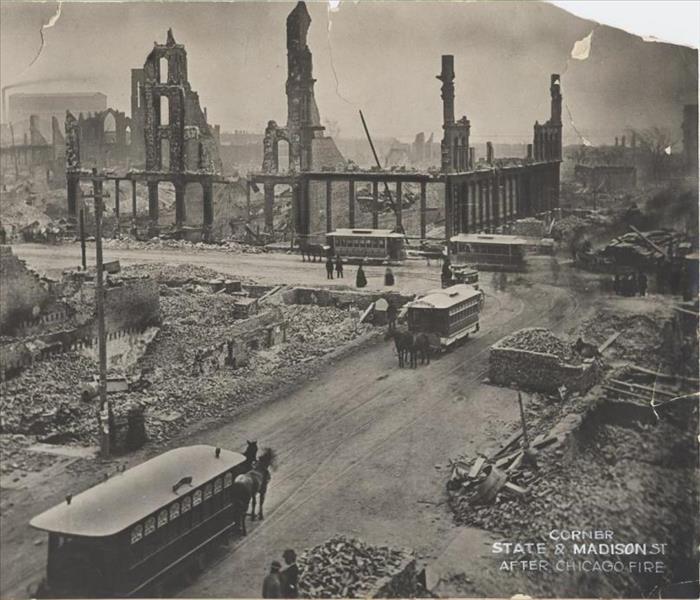National Fire Prevention Week: Oct 6-12, 2019
10/8/2019 (Permalink)
 A photo showing the intersection of State and Madison Streets in which the utter destruction of the Great Chicago Fire can be seen.
A photo showing the intersection of State and Madison Streets in which the utter destruction of the Great Chicago Fire can be seen.
Every year, the second week of October is designated as National Fire Prevention Week, observed in the United States and Canada. This year, Fire Prevention Week is October 6th - 12th. On October 9th, 1920, President Woodrow Wilson issued the first National Fire Prevention Day proclamation. Since 1922, Fire Prevention Week has been observed on the Sunday through Saturday week in which October 9th falls. Beginning with President Calvin Coolidge in 1925, the U.S. President has signed a proclamation proclaiming a national observance during that week. Do you know why this week was chosen? It commemorates the Great Chicago Fire that burned from late in the evening of October 8th through October 10th, 1871. This fire destroyed roughly 3.3 square miles (2,124 acres) of the city of Chicago, claimed approximately 300 lives, and eliminated hundreds of businesses. More than 17,000 structures were destroyed and damages were estimated at close to $200 million (the equivalent of $3.77 Billion in 2016!). Nearly one-third of the city lay in ruins after the fire, and more than 100,000 residents were left without homes - fully one-third of the city's population of the time. This fire came to be known as the Great Chicago Fire and it remains the most famous and known fire in American history.
While the tragedy of the Great Chicago Fire stands as a great reminder of the importance of fire safety, few people know there were many other wildfires and brush fires that dry and drought-ridden second week of October 1871 in the Upper Midwest that caused great loss to both lives and property. The same day the fire in Chicago began, a fire broke out in upper northeast Wisconsin. America's most devastating forest fire scorched over 1.2 million acres of land. Sixteen towns were destroyed, the most damaged being Peshtigo, giving its name to this fire. The town of Peshtigo was consumed in an hour, with the fire claiming the lives of over 800 residents.
The damage estimate was at $169 million, nearly matching the cost of damage in Chicago. But the Peshtigo Fire claimed nearly four times the number of people than perished in Chicago. A Report to the Wisconsin Legislature in 1873 listed 1,182 names of deceased or missing residents following the Peshtigo Fire; in 1870, the town of Peshtigo had 1,749 residents. With deaths across the fire-damaged areas estimated between 1,500 and 2,500, the Peshtigo fire was the most costly fire of that week in terms of loss of lives, and it remains to this day as the deadliest fire in American history. Since local records were destroyed in the fire, an accurate death toll has never been determined. We are thankful to live in a time where we are not only taught fire safety and situational awareness, but we are better prepared to prevent or control such tragic and complete fire damage. If your home or business is damaged by fire, call SERVPRO® to help take back control of your life. We are available and ready to answer your call 24/7/365. Call us at (847) 832-9300. #GreatChicagoFire #PeshtigoFire #FireSafety #FireDamage #FireAwareness #SmokeDamage #SERVPRO #CleanupAndRestoration For more information, visit: https://www.nfpa.org/Public-Education/ARCHIVED/Fire-Prevention-Week-old/About-Fire-Prevention-Week





 24/7 Emergency Service
24/7 Emergency Service